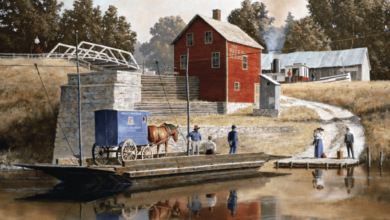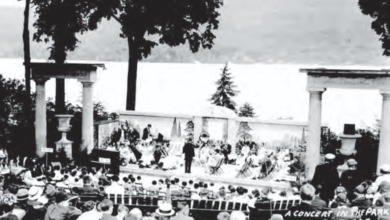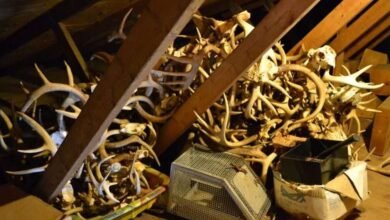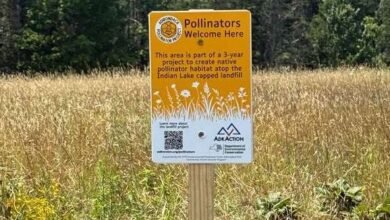Black Locust: An Invasive with Roots?
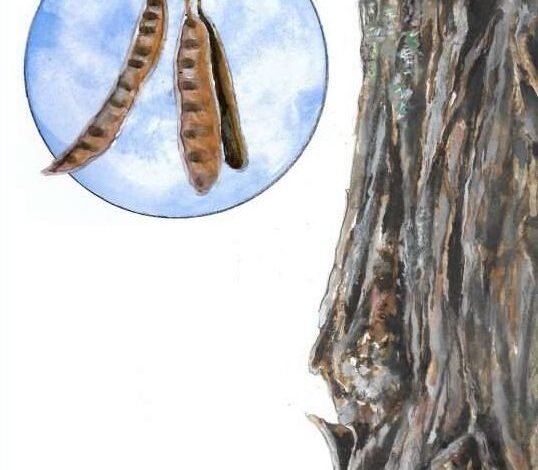

 The coming of autumn often makes trees harder to identify – but sometimes, it does the opposite. The black locust (Robinia pseudoacacia) is a case in point.
The coming of autumn often makes trees harder to identify – but sometimes, it does the opposite. The black locust (Robinia pseudoacacia) is a case in point.
In summer, its bluish-green, oval-shaped compound leaves could easily be confused with those of the honey locust (Gleditsia triacanthos), a close cousin.
Without foliage, though, many of its distinctive traits become visible. Most noticeable are the clusters of flat, papery seedpods, under four inches long, which reveal the locust’s place in the pea family. Developing since midsummer, these pods will now turn brown, dry out, and split open, dispersing their seeds.
Mature trees have grayish-brown bark, with deep, shaggy furrows and crisscrossing, flat-topped ridges. Though saplings don’t yet have the characteristic bark, they do have sharp, sturdy thorns that grow in pairs at the bulbous leaf nodes of the twig.
Black locusts often form airy, sun-dappled groves along country lanes and beside old farmhouses. But they also grow in grittier climes: around highway off-ramps, mall parking lots, and abandoned factory grounds, to name a few.
Forming dense, clonal thickets from their spreading root systems, such locusts are almost impossible to remove and frequently choke out other plants, leading many to declare them invasive.
So what gives? Is the locust an aggressive outsider, or a longtime local? The answer is far from clear. In fact, the U.S. Forest Service’s species profile says that while black locust historically grew in parts of the Appalachians and the Ozarks, “the extent of its original range is not accurately known.”
Part of this enigma may trace back to Native American communities’ widespread use of locust. Among the most rot-resistant woods in North America, locust wood is also remarkably strong and stiff, shrinks little when dried, and is unusually light relative to its hardness and energy density. These traits, along with its fast-growing, hardy nature, made it a good tree to take on the road, and locust seeds were likely traded and planted across eastern North America.
William Strachey (1572-1621), who wrote a firsthand account of the settlement of Jamestown, Virginia in 1610, saw groves of locust, which he described as “a kynd of low tree, which beares a [p]od like to the peas,” growing around local Powhatan villages as though planted.
English naturalist Mark Catesby (1683-1749), traveling in the 1720s, observed that Native Americans across the present-day Carolinas carved bows from black locust, “it being… a very tough and pliant Wood.”
While the uses changed, locust’s importance didn’t diminish with time: in 1814, when American forces won the decisive Battle of Plattsburgh on Lake Champlain, British commentators blamed their defeat, in part, on the black locust, observing that American ships built with locust pegs seemed to fare remarkably well under the shock of cannonball impacts.
This story and others like it gave rise to a boom in locust planting in the early 1800s, with publications like The New England Farmer, a widely circulated agricultural periodical, trumpeting that “many acres on most farms…could not be so profitably appropriated as they may be if devoted to the cultivation of the locust.”
Many of New England’s farmyard locusts – and Locust Hill Roads (in Vermont alone, I count at least four) – probably date to this period. The value of planting black locust, though, went beyond timber.
Like many legumes, locust hosts nitrogen-fixing bacteria of the Rhizobium genus in specialized root structures; this close association increases soil fertility by fixing atmospheric nitrogen in biologically available forms.
This ability was not lost on farmers: another commenter in The New England Farmer wrote that “unlike most other trees, [the locust] invites the grass to grow under it: its small and rounded leaves afford shade from the scorching rays of the sun, retain the moisture of showers and dew in summer, and… enrich the ground.”
It is interesting to realize that, lying with friends under the dappled shade of locust trees on summer evenings past, I have enjoyed – without realizing it – the particular lushness of grass the locust “invites to grow.” Without dismissing the threat that black locust poses to our forests, perhaps we might pause and appreciate the sweet shade this unusual tree casts before its leaves fall.
Sam Blair is a graduate student at the Yale School of the Environment, where he is pursuing a master’s of environmental science. Illustration by Adelaide Murphy Tyrol. The Outside Story is assigned and edited by Northern Woodlands magazine and sponsored by the Wellborn Ecology Fund of New Hampshire Charitable Foundation: nhcf.org.
Source link

